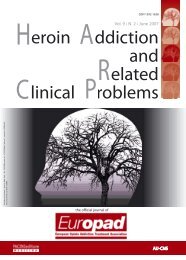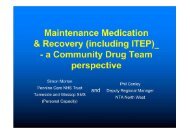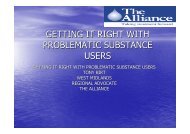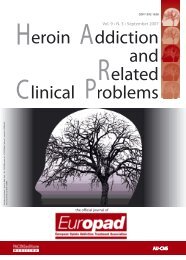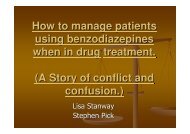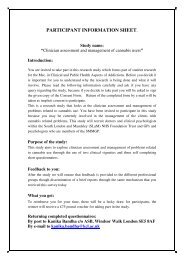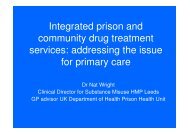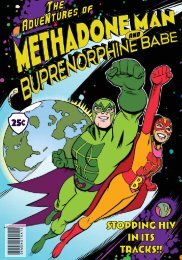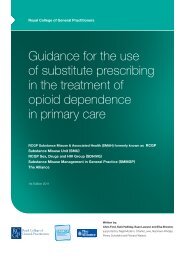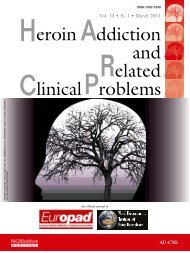15Guidance for working with <strong>cocaine</strong> and crack users in primary careCocaine and the sex industryThere is a growing association between <strong>cocaine</strong> and thesex industry and an increase in risk-taking behaviour.The promise <strong>of</strong> <strong>cocaine</strong> is sometimes used to recruitmen and women into the sex industry. Many sex workersare providing sex for <strong>cocaine</strong> and have little time to accessservices. Crack has been reported as ‘the new pimp’because crack is seen as the new controlling factor insex worker’s lives. 21Unprotected anal and vaginal sex are common as theycommand a higher fee. There is a need to providesexual health advice and safer sex/drug use information.This includes supplies <strong>of</strong> condoms and equipment to allsex workers, as well as easy assess to STI testing andtreatment. It is important to note that reduced vaginalsecretion can increase the risk <strong>of</strong> condom failure.Information for patientsIt is vital to have a supply <strong>of</strong> good information for users<strong>of</strong> <strong>cocaine</strong> in a variety <strong>of</strong> appropriate formats and languages,according to your local needs. These should cover theeffects <strong>of</strong> the drug, harm reduction, interactions withother drugs, and what treatment is available and where.The rights and responsibilities <strong>of</strong> a drug user should alsobe explained and patient choice respected. It is alsouseful to explain general practice and how it works.For a leaflet that can be photocopied and given topatients, please see Appendix 6.There is also a new cohort <strong>of</strong> middle-aged men using<strong>cocaine</strong>/crack, introduced to it as a result <strong>of</strong> buying sex.These patients may not access traditional drug serviceshence primary care interventions are important.Crack and the criminal justice systemIncreasing numbers <strong>of</strong> people who use crack are incontact with the criminal justice system. Doctors, includingGPs, in custody suites, are <strong>of</strong>ten untrained in dealingwith crack users. In addition, there is a lack <strong>of</strong> crackinterventions within prisons and deficient aftercareon leaving.New criminal justice interventions, such as the DrugInterventions Programme (previously called the CriminalJustice Intervention Programme [CJIP]), may confusethe issue for GPs. CJIP developments have resulted inincreased capacity building within the criminal justicesystem, but it potentially causes a criminal justiceperspective towards crack use rather than a health one.Crack users sometimes use short-term sentences as aform <strong>of</strong> respite care. Cravings can disappear, leading tominimisation <strong>of</strong> the problem by the user. However prisoncould and should be seen as a window <strong>of</strong> opportunityfor treatment.
Appendix 1 16Appendix 1Cocaine and healthCocaine and particularly crack can create a number <strong>of</strong> physical and mental health problems in high dose users,some <strong>of</strong> which can be severe. Clinicians need to recognise signs and symptoms <strong>of</strong> <strong>cocaine</strong>/crack use and providethe appropriate medical care needed. All conditions need standard appropriate treatment that would be used whenthese conditions present in any patient, and specific treatment for any <strong>of</strong> the specific conditions, such as crack lung.Physical health<strong>General</strong>The user can suffer from general poor health and achesand pains, as well as specific pains in the shoulders andnumbness in hands. Nutritional status is <strong>of</strong>ten poor andweight loss can result. This can sometimes be seen aspositive by users, especially if there is weight gain fromother treatment, such as methadone mixture orneuroleptics. Users are also at increased risk <strong>of</strong> accidents.The weight loss can be dramatic due to neglecting toeat and the appetite suppressing effect <strong>of</strong> crack.Many users may be combining <strong>cocaine</strong> with other drugssuch as: heroin, methadone, alcohol, benzodiazepines,amphetamines, ecstasy, ketamine and sildenafil (Viagra)etc. and the additional effects on health <strong>of</strong> these othersubstances must be considered.Try to think about <strong>cocaine</strong>/crack use when clusteringand combinations <strong>of</strong> symptoms just don’t add up.Skin problems■ Itching, rashes and eczema.■ Colour change: grey pallor.■ Local burns especially to thumbs and mouth.■ Using/living environment may add furtherskin problems.Chest problems■ There is a range <strong>of</strong> chest problems including breathingdifficulties, developing or worsening <strong>of</strong> asthma,and ‘crack lung.’■ All <strong>of</strong> these can be made worse by cigarette orcannabis smoking.■ Fumes from paint on cans used as pipes, or ammoniawhich has been used in the preparation <strong>of</strong> freebase,can cause coughing and lung damage.■ As <strong>cocaine</strong> has anaesthetic properties, the user maybe unaware <strong>of</strong> the burning due to ammonia fumes,and this can cause damage to lungs and nasalpassages.■ Crack can anaesthetise the lungs, which can decreasethe user’s ability to feel foreign bodies which may enterthe lungs during smoking, such as ash, pieces <strong>of</strong>metal gauze, water vapour and parts <strong>of</strong> plastic pipes,and also decrease the cough reflex which wouldremove these foreign bodies.■ Also on occasions burns to the lungs can occur dueto breathing in the heat from the flame. Risks <strong>of</strong> thismay increase if a burner is used rather than a lighter.■ The action <strong>of</strong> the lung cilia can be reduced, leadingto a reduction in the peak flow and result in worseninglung function. This effect can also make the user moresusceptible to tuberculosis.■ Lung damage can also lead to pleurisy andemphysema.■ Pulmonary embolism can follow the development<strong>of</strong> DVT.Crack lung: This usually occurs 1 to 48 hours afterheavy <strong>cocaine</strong> smoking, and is a form <strong>of</strong> hypersensitivityreaction. Patients may present with dyspnoea, cough,haemoptysis, fever, tachypnoea, chest pain, wheeze andwidespread itching. 22 23 It is unknown whether it isfully reversible.The clinical course can take two forms. 24■ Acute and self-limiting resolving within 24 hours.■ Progressive, with a high percentage <strong>of</strong> patientsrequiring mechanical ventilation. A short course <strong>of</strong>steroids may be <strong>of</strong> benefit.



